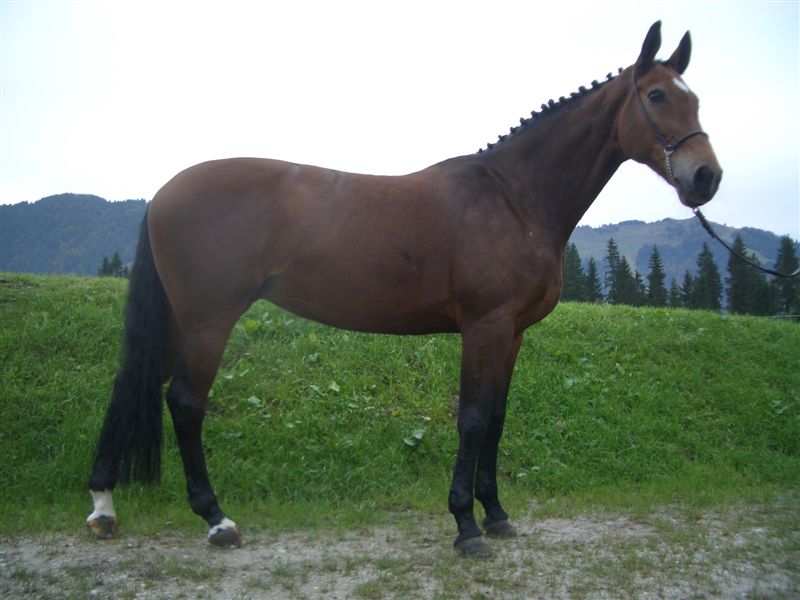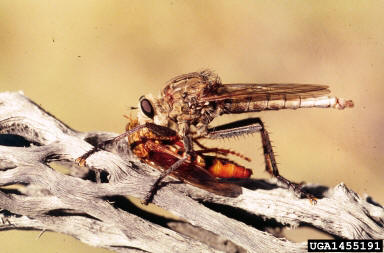Interactions with Other Species
For the many relationships that organisms can have with each
other, G. intestinalis can only have a parasitic bond with the
Equidae Family. A parasite is an organism that latches onto
another organism to get its source of nutrients. This
interaction is beneficial to the parasite but detrimental to the
other organism, known as the host. Horse bot flies’ usually
target species from the Equidae Family such as:
horses, mules,
and
donkeys.
Their first parasitic interaction is when they first hatch inside the mouth of its host. Once inside, they burrow into the tissue of the mouth and could cause multiple problems. The integration of the larva could cause the teeth to loosen, the formation of puss pockets and irritation (Mullen and Durden 2002). After about 3 weeks, the larvae make their way down to the stomach to continue their parasitic lifestyle (McLendon and Kaufman, 2007). They feed on the tissue of the stomach and intestine. They take in nutrients that are supposed to be supplied to the stomach cells. A host can harbor more than one parasite. In fact, Mullen and Durden (2002) say the host can handle up to 100 larvae at once. Larger numbers can cause rise of more complications, however. Severe cases of infestations can cause critical issues like ulcers, tumors, anemia, and paralysis in the esophagus (Pfizer 2007, Williams and Knapp 1999). Their parasitic interaction with its host ends when the larvae are excreted out of the host in its feces (McLendon and Kaufman, 2007). They rise to more interactions when they mature to adults after a month of pupation (Cogley and Cogley 2000).
After they emerge as adults, they begin to interact with other bot flies to reproduce and find a host. When laying eggs, the females are relentless and determined to lay its eggs on a host. They are almost oblivious to other obstacles because they are so focused on laying eggs on the fore legs of horses (Cogley and Cogley, 2000).
Bots are not without problems of their own. Other organisms feed
on bots during their adult stage as well as their pupa stage. Common
fly eating organisms like bats and nighthawks feed on bots. The bot
flies’ way of escaping is with its capability to fly extremely fast
speeds, up to 50 mile s per hour (Encyclopedia Britannica, 2014).
However, such predators are also capable of catching bots out of the
air in one fell swoop (Anderson, 2008). Larvae also fall victim to
parasitic wasps during their pupation period. The wasps lay eggs on
the bot flies and kill them during their parasitic interaction
(Anderson, 2008). Another organism that is capable of devouring bot
flies are robber flies, or Asilidae. When bot flies are flying
around, robber flies can overwhelm the fly and quickly inject its
prey with its mouth, like a
mosquito. It sucks the interior contents
of the fly dry.
s per hour (Encyclopedia Britannica, 2014).
However, such predators are also capable of catching bots out of the
air in one fell swoop (Anderson, 2008). Larvae also fall victim to
parasitic wasps during their pupation period. The wasps lay eggs on
the bot flies and kill them during their parasitic interaction
(Anderson, 2008). Another organism that is capable of devouring bot
flies are robber flies, or Asilidae. When bot flies are flying
around, robber flies can overwhelm the fly and quickly inject its
prey with its mouth, like a
mosquito. It sucks the interior contents
of the fly dry.
Whitney Cranshaw, Colorado State University, Bugwood.org
Horse bot flies don’t have intent to cause harm to humans. The females have the instinctual drive to lay eggs on horses that they usually ignore humans as a whole (Cogley and Cogley, 2000). However, there have been cases where they lay eggs on humans and larva start growing in perpetually moist areas, like the eye.
Bot flies can be quite the nuisance, learn how to treat against them!
Want to go home?